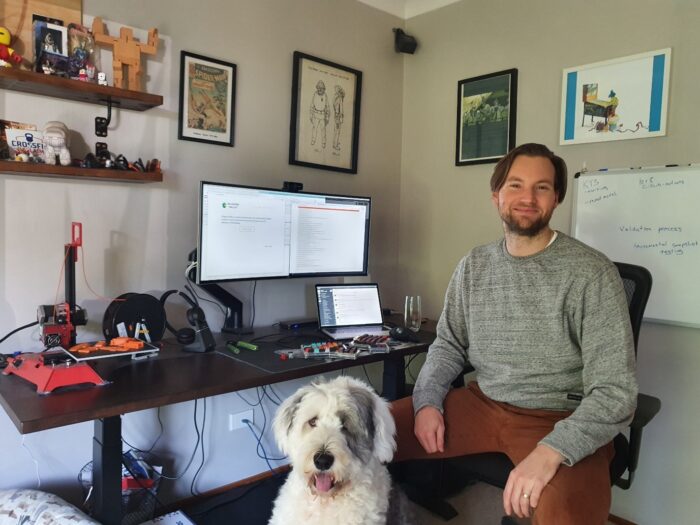At the height of the coronavirus crisis in April 2020, 4.5 billion people around the world were living under social distancing measures, according to the AFP news agency. We adapted in many ways, but one key learning from this unprecedented event is that working remotely really can work.
For many of us, the lockdown period offered a fresh new perspective on working from home. Cutting out lengthy commutes and unnecessary meetings allowed for greater productivity and better work-life balance, while digital technology made team catch-ups and collaboration easy.
As restrictions ease, savvy businesses are reconsidering the standard office set-up for the future. Twitter is one big-name tech company that’s already announced its employees can now work from home permanently if they choose, as has Spotify.
In Australia, many businesses are staging a staggered return to the office to allow for social distancing, meaning employees will continue working from home at least a few days per week. As well, employees are looking for opportunities that provide more flexibility for remote work, blended with office time.
The benefits of remote work
The Centre for Future Work estimates that 30 per cent of the Australian workforce could feasibly work from home – and there are many benefits to switching to this model as we navigate our post-COVID-19 world.
This is especially the case for many based in Wollongong, where 23,000 people used to commute daily to Sydney prior to the pandemic.
Here, we hope to give managers of Wollongong residents a fresh perspective on remote work, and also give those of us who commute to Sydney some ideas on how to approach the ‘working from Wollongong’ discussion with your managers.
One great advantage for businesses who embrace remote work is that the talent pool instantly widens. “The biggest benefit is the access to employees, because you can now source employees anywhere,” says workplace expert Michelle Gibbings. “If they can work from home you don’t need them to be geographically based.”
Wollongong local Jess Belliveau (pictured below) is one great example of how remote work has cast a wide net for talent – the infrastructure engineer works for US-based software company Apptio from his home in the regional coastal city an hour south of Sydney.
“I work as part of a global team for Apptio,” Jess says. “My role varies constantly but primarily I support our developers in delivering applications. As Apptio is a SaaS (software as a service) company, we aren’t bound to a single location.”

Establishing a work-from-home policy is a great way for businesses spending large amounts of money leasing offices in Sydney or Melbourne to reduce costs, allowing companies to downsize, open a satellite office in a regional city or even do away with their office altogether.
Employees working from home also tend to be more productive and take shorter breaks and fewer sick days, according to a two-year study published in The Quarterly Journal of Economics.
In Wollongong there’s also several great coworking spaces, including Smart Space, Work Life and Zig Zag Hub, each offering options for Wollongong-based team members to be amongst others but avoid the unnecessary hours lost commuting to Sydney.
Michelle says the productivity boost seen in remote workers likely comes from removing office-workers’ commute, which has flow-on effects throughout the day.
It means that when you’re working, you’re more productive, because you can be incredibly focused on what you need to get done through the day.
“You’ve then got more time at the end of the day to spend with family, so you’ve got better work-life balance,” she explains. “That actually makes it easier for people to be more engaged and more productive at work because they don’t have that torn emotion of, ‘I feel like I need to keep working to get things done, but I also want to spend time with my family’.”
A Wollongong office base is a great option for businesses looking to take advantage of the productivity boost generated by a better work-life balance from reduced commute times. Average commute times within Wollongong range between 10 and 40 minutes, depending on the mode of transport. Even if employees only work in the office a few times a week, a shorter travel time into the office may make people more enthusiastic about visiting HQ.
Setting the boundaries
Of course, remote work comes with challenges and pitfalls to be aware of, too. If you’re keen to transition to a work-from-anywhere lifestyle or want to offer your employees more flexibility, it’s important to set expectations around practicalities like working hours, communication methods and regular catch-ups to ensure a smooth long-distance relationship.
“The more you discuss and agree collectively on how you work together, that’s when you get the best of everybody,” says Michelle.
For Jess, the flexibility that working remotely offers is a big win, allowing him to take full advantage of the beaches, bush walks and bustling café culture that drew him to Wollongong in the first place.
“Apptio allows me to self-manage and has a high level of trust in its staff,” he explains. “Weekly one-on-ones with my team lead and project stand-ups help to provide updates on what I’m working on and whether I am tracking on meeting my obligations.”
If you’re planning on working from home long-term, you’ll need to ensure you have the right technology to support your job, such as a strong and reliable internet connection, access to the software your job requires and a good audio and web-cam set-up for phone and video calls.
Wollongong’s digital connectivity has made it an appealing location for many entrepreneurs, businesses and remote workers to base themselves.
“Make sure you have a dedicated office area set up – no, not the kitchen bench with a stool,” adds Jess. “It’s super important to be comfortable and provide yourself something ergonomically sound.”
If your company is encouraging you to continue working remotely, they may reimburse you for some of your home office costs. While reducing overheads is an incentive for businesses to embrace telecommuting, the Centre for Future Work’s recent report Working From Home: Opportunities and Risks advises against employers simply passing on all their office expenses to staff.
“Allowances for all employees required to perform some or all of their duties from home should be considered – designed to fairly reflect ongoing work-related costs (including space, data charges, utilities and printing),” the report recommends.
Working effectively online
To managers, the home environment can seem full of distractions. But in practice, without interruptions from colleagues and meetings, remote workers often experience long bouts of “deep work”, where they’re fully focused on their task. For this reason, both Michelle and Jess suggest building regular breaks into the work-from-home day as a buffer against burnout.
“Separate your time between work and home – ideally, have set hours when you disconnect, or just manage what works best for you and your work style,” tips Jess from Wollongong.
“Work is great and all – but always look after yourself. I don’t chain myself to my desk, and I give myself plenty of breaks!”
Employers might be unsure of how to track their employees’ productivity remotely, but Michelle says it’s important to trust staff, and measure their progress by output. “The notion that we need to monitor employees all the time is quite dated,” she says.
“Most research shows that, yes, employees want to get paid, but they also want to know that they’re adding value, they’re appreciated for their work, and that they’re making a sense of progress. It has a great impact on our motivation levels and our productivity.”
Clear communication is vital, she adds – managers and employees need to be on the same page around what needs to be delivered and when. Tools such as Trello, Asana or Wollongong’s own Accelo software for professional services firms, can help here, by allowing teams to allocate tasks and manage workflow virtually. Meetings can happen on Zoom or Skype, and Michelle suggests online app MURAL and Miro for digital team brainstorming.
“As a global team, we not only deal with being remote, but geographically dispersed, so time zones become an issue,” Jess shares. “We rely heavily on Slack – this chat app lets us handle day-to-day comms, but we also tie in our automation and alerting.
“We have a bunch of non-work-related Slack channels so you can ‘water-cooler’ chat with other people around the world and build relationships, not just around work projects. Otherwise, we hold all our meetings over video via Zoom or Slack. Email still plays a role, but we try to make heavy use of the [collaborative software] Confluence blogging features to table ideas and solicit feedback.”
Creating community
One big challenge remote workers face is a sense of isolation, as they miss out on the social aspect of a shared workspace. There’s also the modern issue of digital overwhelm, recently coined ‘Zoom fatigue’, where workers experience exhaustion from an overload of online interactions. To counter this, Michelle (pictured below) suggests establishing a day a week or a month for employees to come together for face-to-face collaboration.

“The office isn’t dead,” according to Michelle.
“There is absolutely the ability to work from home, but there will be times when people need to come into the office and they will want to come into the office to do different things.”
Just an hour south of Sydney and serviced by two airports, Wollongong is a connected city that’s ideally placed for remote workers who need convenient access to their company’s headquarters. It’s an easy drive or train ride to Sydney, or a short flight to other capital cities. And for those who freelance or work too far away from their office for regular visits, co-working spaces provide a key opportunity for socialising and business networking.
As a self-confessed extrovert, Jess has made an effort to seek out community in Wollongong. “Cafés are my secret weapon!” he says. “I often work from a café two or three hours a week – Steam Heads and Léchappé Cycle Café are my go-tos. Cafés allow me to get some face to face human interaction and enjoy a much better coffee than the swill I can manage at home. I always try and respect the café though and not overstay my welcome.”
Wollongong’s café culture has exploded in recent years, our CBD is filled with boutique café’s, giving remote workers plenty of choice of where to take a pitstop. And after work, you can easily meet up with your friends (or other remote workers) at one of Wollongong’s hip bars or restaurants. All without having to grapple with major city traffic congestion nightmares.
- Check out Wollongong CBD’s business directory to explore some of the city’s great cafes and casual dining options
A canine colleague, Barnaby, keeps Jess company in his home office, while Slack chats help Jess create connection with his team-members around the world. “We try to share things going on in our lives, or photos from where we are based to build that team mentality,” he explains. “About a year ago I instigated a weekly Friday trivia session on Slack, and now Zoom. Initially it was team based but it’s spread to be open to anyone in Apptio. It’s a great chance to have a laugh, connect with people and meet new starters.”
He also recommends connecting with business groups and attending local networking events.
“We are super lucky in Wollongong to have initiatives like Siligong Valley, where like-minded people can connect and share knowledge. And there are a number of great local events found via the Meetup site,” he explains. “I’d implore anyone working remotely to not socially isolate themselves! Reach out to the community and you will find others with similar interests, I’m sure.”
Regardless of what your line of work is or interest are there will be a business network for you in Wollongong. Whether it is small business, tech, film, creatives or advanced manufacturing – you’ll find “your people” right here. And best of all, Wollongong is known for its welcoming nature and community spirit, so you will feel at home (and supported) in no time.






